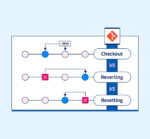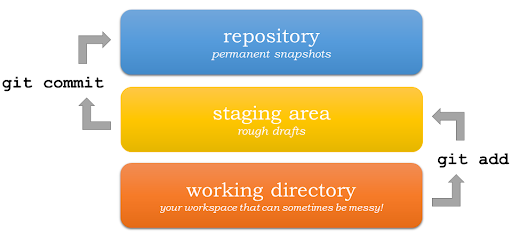Table of Contents
Introduction
Tracking any code changes is crucial, whether you build websites or apps or any digital product. This is where source control systems come in.
This beginner’s guide will take you through version control, why it is mandatory for developers, the types of version control systems, and popular tools like Git, the most widely used control system in software development as of now.
What Is Version Control?
A source code management system tracks changes made to files over time, allowing you to revisit earlier versions when needed. This practice is also known as revision control or code management.
It enables development teams to do the following:
- Collaboratively modify the code without one fellow programmer overwriting another’s work.
- Track changes, fixes, and features over time.
- Rollback for a previous version when bugs or issues go in.
- Create branches for testing and merge later.
Think of it as a time machine for your code.
Why Use Control Systems?
Still wondering why developers need version control? Here are some key benefits:
1. History and Traceability
The logging of code changes encompasses timestamps, a description of the change, and the name of the developer responsible for it, establishing a complete audit trail.
2. Team Collaboration
When multiple developers are working on the same project, there are no conflicts since they can use tools to merge their changes and resolve overlaps.
3. Backup and Recovery
Whenever something goes wrong, you can revert to the last stable version. There is no fear of breaking your code base anymore.
4. Experiment Safely
You can create a branch, do your experimentation with new features, and merge it back later. This gives you the freedom to experiment safely.
5. Better Code Reviews and DevOps
Code revision system supports pull requests and automated testing, streamlining CI/CD pipeline integration for smoother workflows.
Version Control in Software Development: A Real-World Example
Consider designing a mobile application. Now, suppose you accidentally delete a very important function. Without source control systems, loss here could amount to some hours or even days of work. If you are using a code management tool, you can roll back the file within seconds to a previous commit.
In the team setup, each developer can work on different features in their branches, test their code, and merge when approved. The main codebase, often referred to as the main or master branch, remains stable..
Types of Source Control Systems
Understanding the types of source control helps you choose the right system for your needs.
1. Local Source Control Systems
- Tracks files on a single developer machine.
- Simple but lacking robust interoperability and prone to data loss.
- Example: RCS (Revision Control System).
2. Centralized Version Control Systems (CVCS)
- Stores all files and changes on a single computer server.
- Developers pull/push their files from the same location.
- In case the server crashes. You lose everything.
- Example: Subversion (SVN), CVS.
3. Distributed Version Control Systems (DVCS)
- Every developer gets a full-fledged copy of the repository.
- This makes operations faster, and offline access easier, while also providing better backup safety.
- It is this model that most modern projects operate on.
- Example: Git, Mercurial
Today, Git is the most widely used DVCS.

Git: The Most Popular Version Control System
Git is a free and open-source control system created by Linus Torvalds in 2005. It is the basis for GitHub, GitLab, and Bitbucket.
Key Features of Git:
- Distributed architecture
- Lightweight branching
- History and log of commits
- Merge and rebase
- CI/CD and DevOps integrations
With Git, developers can:
- Track Changes Command (git log)
- Stage Files Command (git add)
- Commit Changes Command (git commit)
- Branches Command (git branch)
- Merge branches (git merge)
- Revert issues (git reset, git revert)
This makes it a powerful tool for both individual and team-based software development.
Popular Version Control Tools
Here are some of the most popular version control tools used by developers today:
| Tool | Type | Best For |
| Git | DVCS | Projects of all sizes, solo & teams |
| GitHub | Hosting + Git | Open-source collaboration |
| GitLab | Hosting + DevOps | Full CI/CD pipelines |
| Bitbucket | Git Hosting | Private projects & teams |
| Subversion (SVN) | CVCS | Legacy enterprise systems |
| Mercurial | DVCS | Lightweight, Git alternative |
Getting Started: VCS Tutorial for Beginners
If you’re new to source control, here’s how to start with Git:
# Step 1: Install Git
https://git-scm.com
# Step 2: Configure Git
git config –global user.name “Your Name”
git config –global user.email “you@example.com”
# Step 3: Create a Repository
git init
]# Step 4: Track a File
git add filename.js
# Step 5: Commit Your Changes
git commit -m “Initial commit”
# Step 6: Connect to GitHub and Push
git remote add origin https://github.com/user/repo.git
git push -u origin main
That’s it you’ve started using a version control system like a pro!
Summary: Why Version Control Matters
Here’s a quick recap of why control systems are essential:
| Benefit | Explanation |
| Collaboration | Work on the same codebase with others |
| Safety | Revert bugs or mistakes instantly |
| History | Track who changed what and when |
| Scalability | Supports small to large-scale projects |
| DevOps Integration | Enables automation, CI/CD, and agile workflows |
If you’re working on software development, there’s no excuse to not use a control system especially when Git is free, flexible, and easy to learn. You can refer to our latest articles here.









